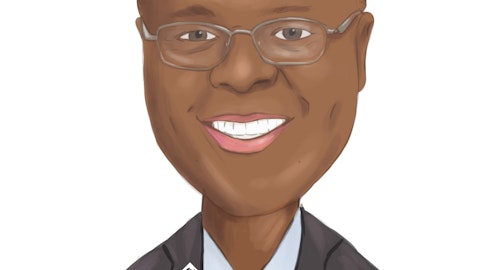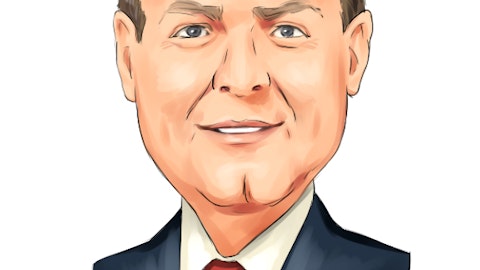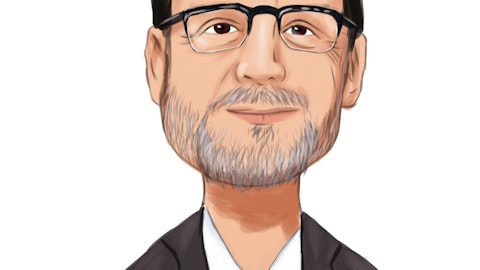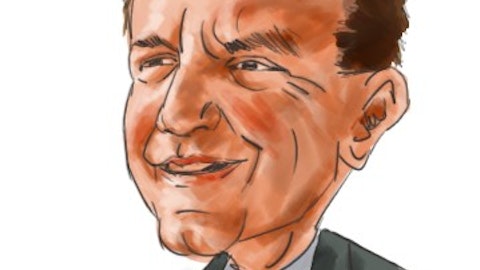Hancock Whitney Corporation (NASDAQ:HWC) Q4 2022 Earnings Call Transcript January 17, 2023
Operator: Good day, ladies and gentlemen, and welcome to Hancock Whitney Corporation’s Fourth Quarter 2022 Earnings Conference Call. At this time all participants are in a listen-only mode. Later, we will conduct a question-and-answer session, and instructions will follow at that time. As a reminder, this call may be recorded. I would now like to pass the call over to your host for today’s conference, Trisha Carlson, Investor Relations Manager. You may begin.

Photo by rupixen.com on Unsplash
Trisha Carlson: Thank you, and good afternoon. During today’s call, we may make forward-looking statements. We would like to remind everyone to carefully review the safe harbor language that was published with the earnings release and presentation and in the Company’s most recent 10-K and 10-Q, including the risks and uncertainties identified therein. You should keep in mind that any forward-looking statements made by Hancock Whitney speak only as of the date on which they were made. As everyone understands, the current economic environment is rapidly evolving and changing. Hancock Whitney’s ability to accurately project results or predict the effects of future plans or strategies or predict market or economic developments is inherently limited.
We believe that the expectations reflected or implied by any forward-looking statements are based on reasonable assumptions, but are not guarantees of performance or results and our actual results and performance could differ materially from those set forth in our forward-looking statements. Hancock Whitney undertakes no obligation to update or revise any forward-looking statements, and you are cautioned not to place undue reliance on such forward-looking statements. Some of the remarks contain non-GAAP financial measures. You can find reconciliations to the most comparable GAAP measures in our earnings release and financial tables. The presentation slides included in our 8-K are also posted with the conference call webcast link on the Investor Relations website.
We will reference some of these slides in today’s call. Participating in today’s call are John Hairston, President and CEO; Mike Achary, CFO; and Chris Ziluca, Chief Credit Officer. I will now turn the call over to John Hairston.
John Hairston: Thank you, Trisha, and good afternoon and Happy New Year to everyone. Thanks for joining us on what I know is a very busy day. While we look forward to the start of a new year, we also want to celebrate a successful Q4 and a strong conclusion to 2022. We are exceptionally proud of the Hancock Whitney team and the Company’s overall performance during a remarkable year of volatility. The results revealed not only progress made in 22, but also the culmination of decisions made the last several years to better position the Company. With year-over-year earnings up $61 million, PPNR up nearly $104 million, net loan growth up $2 billion, NIM up 31 basis points and an efficiency ratio in the low-50s, we view 2022 as a very successful year.
We see another year of potential macro environment changes coming in 2023 and expect the bulk of investor interest to be more about the future. As such and as promised, we have updated our three-year corporate strategic objectives or CSOs, and we provide 2023 guidance on slide 18. Our guidance for 23 shouldn’t be a surprise or a trend much different from what you may hear from others in our industry. Loan growth in the low to mid-single digits reflects the recognition of a likely slowdown in the economy, and we are mindful of managing risk in such an environment. We expect continued hurdles with funding loan growth with deposits and are guiding to an environment where core deposit growth will be available, but perhaps a little bit more rate sensitive.
Our intense focus will be on core relationship lending with accompanying deposit relationships, which create meaningful value in our balance sheet through the cycle. This focus will have the impact of a slowing loan growth in 23, but a better chance of funding lending with deposits. We fell short of that goal in Q4 as loans outperformed and the timing of seasonal deposit inflows and outflows was different than we expected. We said for the last couple of years that line utilization would begin returning to pre-pandemic normal, at the same time, excess commercial deposits are spent, and that trend was evident in the last several quarters, including Q4. But with that said, we intend to grow deposits in 23 in the low single digits with a downside case of flat where we use cash flow from the bond portfolio to fund any shortfall in deposits.
To the extent deposits outperform, we will adjust to reinvesting in bonds or deploying into loans dependent upon the environment at the time. The rate environment, while beneficial to net interest income negatively impacted fee income with secondary mortgage being the hardest hit. With trending strong performance in wealth and card fees, though, we believe we can grow total noninterest income 3% to 4% in 2023, including in covering the replacement of $10 million to $11 million of lost income from the elimination of certain NSF/OD fees beginning in December of 2022. Inflation pressure, pension expense and notable increases in FDIC assessments are a few of the drivers guiding to a 6% to 7% increase in 23 noninterest expense. Backing out the pension and FDIC increases, we project a 4% to 5% increase compared to 22.
Our efforts over the past three years in reducing expenses have put us in a position to better adjust to these increases and still maintain an efficiency ratio in the very low-50s. And finally, as it relates to guidance, we believe today’s results for both the quarter and the year reflect the Company positioned well for today’s economic environment. Credit metrics are at historically low levels. Initiatives executed in 20 to 22 helped drive an efficiency ratio below 50% in the fourth quarter. New bankers hired over the past 18 months should help attract and enhance relationships in growth markets. We’ve proven our ability to proactively manage expenses and are introducing technology focused on scalability and effectiveness. Capital remains solid, our reserve is solid and our balance sheet is derisked and positioned well.
So with those comments, I’ll turn the call over to Mike for further comments.
See also 11 Best Debt Free Stocks To Buy and 14 Best Dividend Stocks To Buy and Hold.
Mike Achary: Thanks, John, and good afternoon, everyone. We ended 2022 with fourth quarter EPS of $1.65, up $0.10 linked quarter. Net income of $144 million, was up $8.4 million from the third quarter. PPNR was up $10.3 million. And finally, our efficiency ratio came in below 50% at 49.81%, certainly, a nice way to end a very solid 2022. Loan growth came in stronger than expected during the quarter at $528.5 million or up 9% annualized from last quarter. Line utilization continues improving and is trending back to pre-pandemic levels, while our residential onetime close product drove a sizable increase in mortgage loans. Deposit growth for the Company came in lighter than expected at $119 million or 2% annualized from last quarter.
Typical seasonality in public funds contributed $494 million while time deposits were up $493 million due to a CD promotion during the quarter. DDA and interest-bearing transaction deposits were down $692 million and $176 million, respectively. We recognize that deposit growth will be a challenge in 2023 for both, our company as well as the industry. Commercial clients are deploying excess liquidity into working capital, while consumers are becoming more rate sensitive. You can see on slides 13 and 14 in the earnings deck that while we were successful in holding deposit betas relatively low for most of this year, we did see a pivot up in our deposit beta to around 21% in the fourth quarter. Excluding the seasonal increase in public funds, that deposit beta was closer to 14%.
We still believe that when the current rate cycle is done, that our cumulative total deposit beta should be no worse than around 25%, so about the same as the last up cycle. Our fourth quarter NIM at 3.68%, was up 14 basis points linked quarter. So, while that level of widening is impressive on its own, admittedly, it did not move up as much as we expected coming into the quarter. The yield on new loans jumped 134 basis points to 6.27%, and the bond portfolio increased 12 basis points, adding 51 basis points to our earning asset yield compared to last quarter. Funding costs were higher this quarter as expected, mostly due to promotional pricing on a successful CD offering that did result in higher deposit costs and a shift in our funding mix.
We still believe our NIM has room to expand with future rate hikes, but it will be small and very dependent on the level, mix and cost of deposits. Concluding my comments with credit, our metrics trended to historically low levels in 2022 and remain there. Negative provisions ended as future CECL scenarios call for a potential slowdown in possible recessionary environment. Our provisioning has been modest and charge-offs remain low, and we believe we’re positioned well with an ACL of 148 basis points. So, while that ratio did decline by 2 basis points linked quarter, we actually added $1.5 million to the reserve at year-end. With that, I’ll turn the call back to John.
John Hairston: Thank you, Mike. Okay. Let’s open the call for questions.
Q&A Session
Follow Hancock Whitney Corp (NASDAQ:HWC)
Follow Hancock Whitney Corp (NASDAQ:HWC)
Operator: The first question comes from the line of Brad Milsaps with Piper Sandler.
Brad Milsaps: I appreciate all the guidance in the slide deck. I did maybe want to jump in maybe the fee income guidance first. Obviously, a lot of moving parts this quarter. You note some of the specialty items may be lower than they have been. Typically, you’ve got the headwind with the NSF fees of about $10 million to $11 million. Is really the swing factor some of those specialty items coming back, or John, are there other segments or endeavors that you have out there that you feel like are going to be able to kind of push that number up higher towards your guidance?
John Hairston: Yes. Good question, Brad. This is John. I’ll start off and Mike is welcome, too. You gave a quick inventory of exactly the right things to point to. The NSF/OD income, we forecasted, I think we talked about that maybe 3 or 4 quarters ago, that to be a $10 million to $11 million annualized hit that started in December of 22. So first quarter 23 will bear the full blunt of that run rate. But as balances in consumer business accounts continue easing down to pre-pandemic level, we anticipate that overall service charges from the deposit book and deposit accounts will keep going up throughout the year. We also anticipate a very strong performance from our wealth management group. Fourth quarter was very promising as we anticipated.
And we think we’ll go into 2023 with an awful lot of momentum. And then finally, all things card-related continue to outperform, and we expect that to also be a very good performance for the year. So, all in all, the 3% to 4% guide is inclusive of covering the downside from the NSF/OD fee changes. You mentioned the other income bucket, and there’s a lot of cats and dogs in that bucket. And for the fourth quarter, it was unusual and that virtually every one of those categories was at a lower run rate level or lower level than we typically experienced in the run rate. And we do expect that to bounce back to something more closely to overall 2022 performance or maybe a little bit better. So, all of those factors are rolled into the 3% to 4% guide for the year.
The only area that we’re not counting on, Brad, is a secondary fee income for mortgage. It does appear after about a 54% reduction in deal flow quarter four 21 to quarter four 22. We think we’re at or pretty near the bottom on that particular fee income source. So, while we’re not counting on any benefit through 23, any beneficial movement in 30-year rates would obviously be an unexpected benefit. So, we don’t have that expected at all in our numbers, but that would be a little bit more of an upside or a tailwind. Did I answer your question, okay?
Brad Milsaps: Yes, John, very helpful. And maybe as a follow-up to Mike, as it relates to the CSOs, I see that you put sort of a framework of kind of your assumptions around Fed funds for the next three years. I know rates are moving up, initially, you were looking for 4 to 6 basis points of NIM expansion with each 25 basis-point increase. Would there be a similar level of contraction on the way down if and when we get there? Or — I know it’s probably a tough question given all the moving parts. But just curious kind of how to think about — I can’t believe we’re talking about rate cuts already, but just how we would think about that as it relates to NIM?





